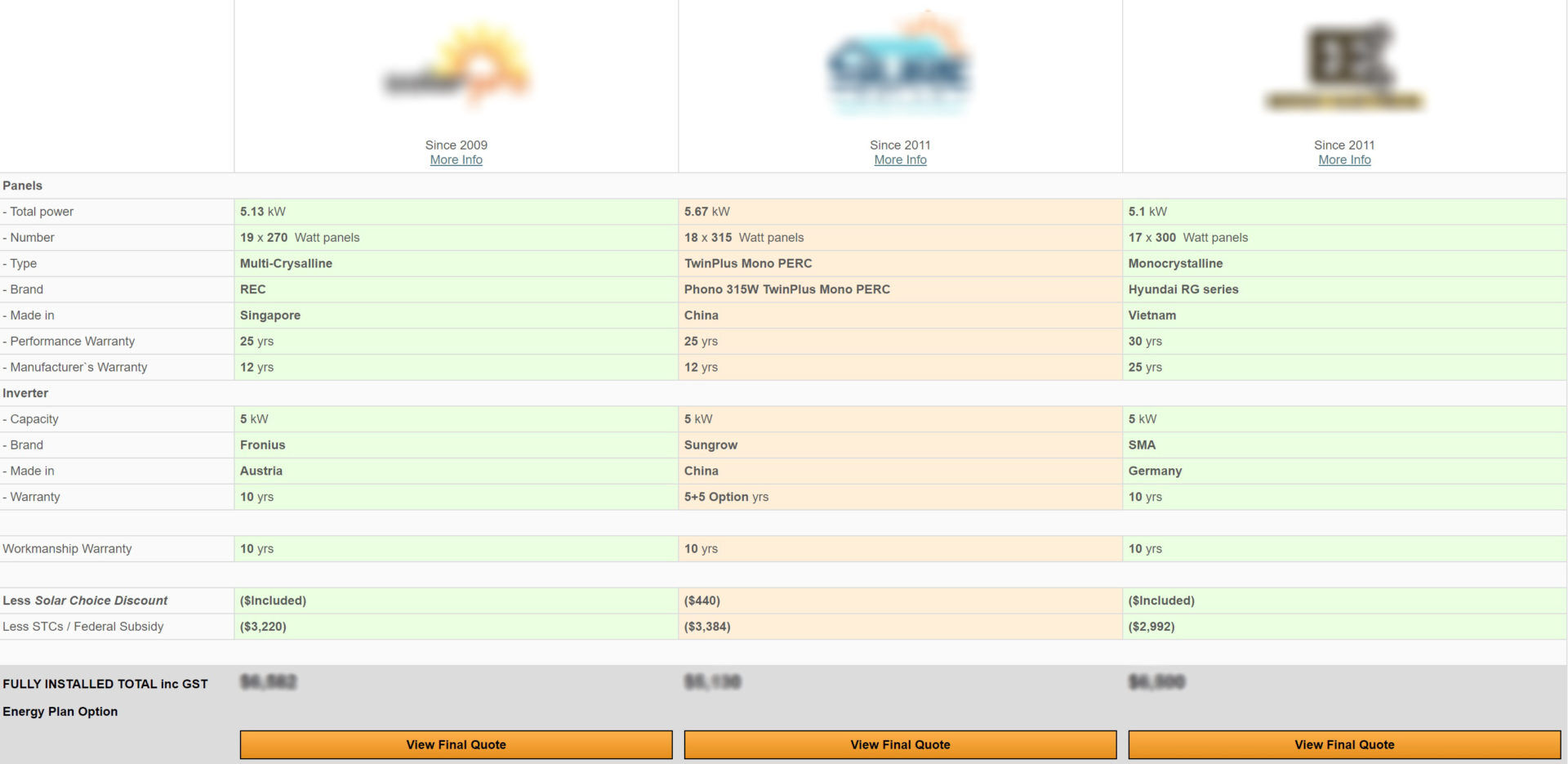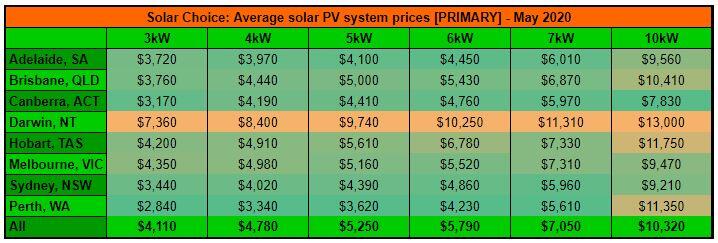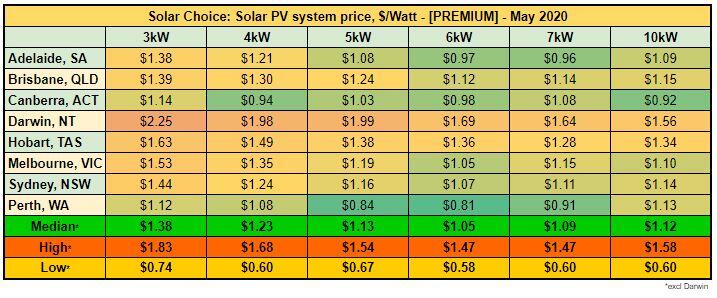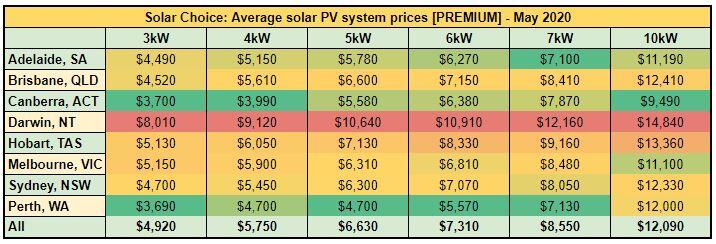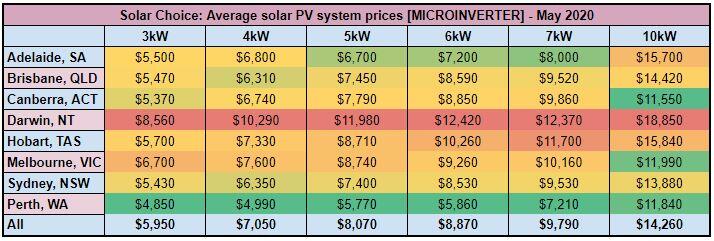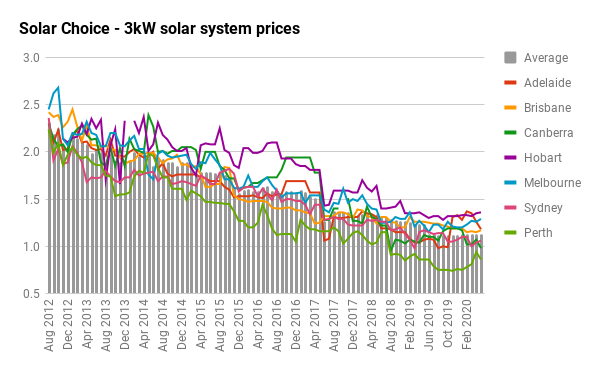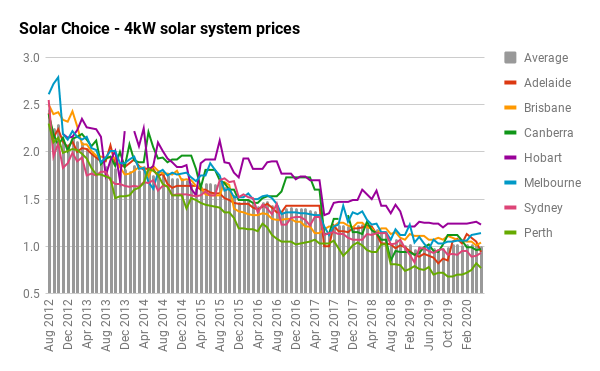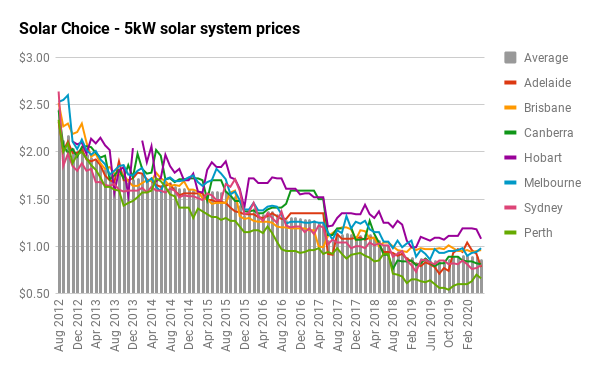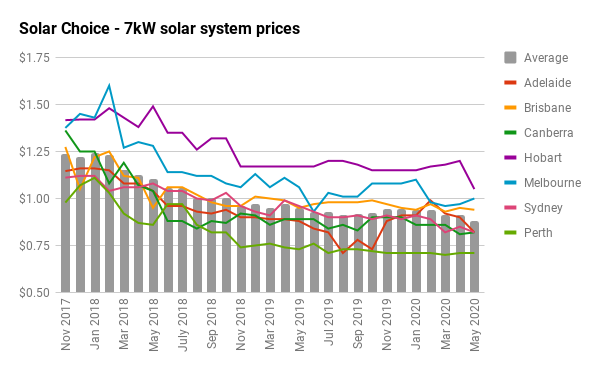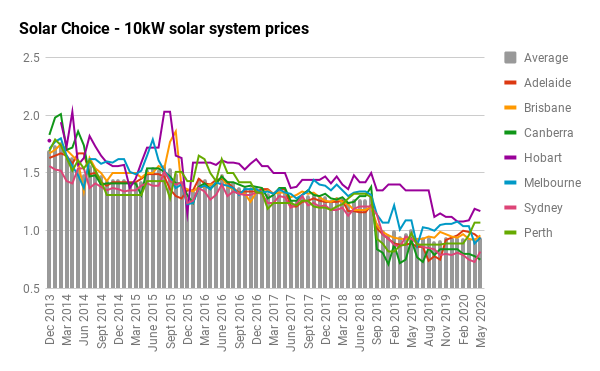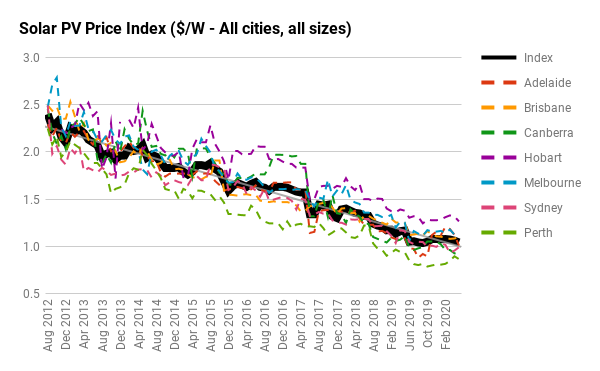Average residential solar system prices have slightly decreased to $1.04 per watt ($/W) this month on the back of several factors, including changes to the composition of the Solar Choice installer network and updated pricing from installers that we work with. We have now removed 1.5kW, 2kW and added 6kW to our Price Index due to the rise in 6kW popularity. This has also helped to bring down the average due to the sharp 6kW pricing seen across the market.
Meanwhile, average prices for popular 5kW systems slightly increased compare with March, at $0.90/W, or about $4,500 out-of-pocket. ‘Premium’ and ‘microinverter‘ options for the same size system are coming in at about $5,850 and $7100, respectively.
Average solar PV system prices for May 2020
Primary offerings are the default (and most popular) type of systems that retailers and installers display on Solar Choice’s Solar Quote Comparisons (see screenshot). They are generally the lowest-price offer from a particular installer.
Prices in the table below include both the up-front incentive available for small-scale systems through the Renewable Energy Target (STCs) and GST – they represent the total out-of-pocket cost of the system to the customer. We’ve left fields blank where there were only a small number of price points available in our database (usually fewer than 3).
Prices for each system size are colour-coded. (Dark red for highest, dark green for lowest, yellow/orange for in between).
Compare quotes from up to 7 pre-vetted installers in your area now.
Since 2008 our knowledge and sophisticated software has allowed over 160,000 Australian households and businesses to make a well-informed choice on their solar & battery installer.
List of products used in primary offerings
Please note that the below list is in alphabetical order and does not denote panel-inverter pairings in installer offerings.
| Products used in primary offerings | |
| Panels | Inverters |
| BYD | ABB |
| C Sun | Flex |
| Canadian Solar | Goodwe |
| EGing | Growatt |
| ET | Huawei |
| Flex | Opal |
| Hanwha | SMA |
| Infinity | SolarEdge |
| JA Solar | Solax |
| Jinko | Solis |
| LG | Sofar |
| Linuo | Sungrow |
| Phono | Zever Solar |
| QCells | |
| REC | |
| Risen | |
| Seraphim | |
| Suntech | |
| Talesun | |
| Trina | |
| Xtreme | |
| ZN Shine | |
Compare solar & battery quotes from installers in your area:
Compare Solar & Battery Quotes
Solar system prices for May 2020: $/W medians, highs & lows
This table includes data for primary, premium & microinverter systems. (Click to enlarge.)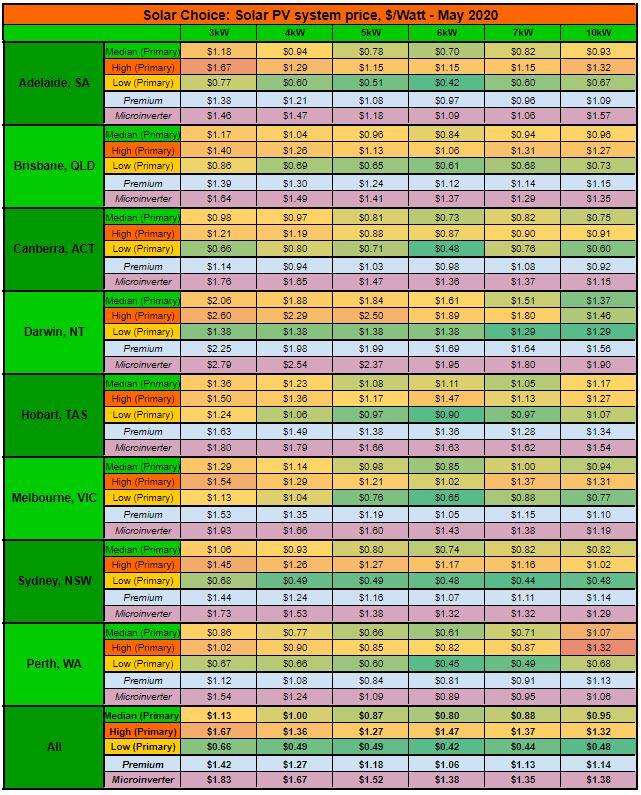
Prices above are colour-coded across highs, lows & medians for all cities and system sizes. (Dark red for highest, dark green for lowest, yellow for middle. Cells are grey where only a small set of data points was available. Please note that premium and microinverter options are not colour-coded.)
Premium solar system offerings for May 2020
Solar installers & retailers also upload pricing for ‘premium’ solar system offerings on the Solar Choice portal; these offers can then be viewed by Solar Choice customers. The definition of premium is not hard and fast, and usually comes down to the installer’s selection of components. Oftentimes, premium offers will consist of the company’s standard panel offering but a different brand of inverter – but many installers may offer a higher-end brand of panel as well.
It’s important to note that the range of products used in these systems will vary greatly, and that not all premium systems are equal in their quality; in fact, one company’s premium system may be another company’s primary offering. Be sure to do your research into the brands being offered before making your decision.
Prices in the tables below include both the up-front incentive available for small-scale systems through the Renewable Energy Target (STCs) and GST – they represent the total out-of-pocket cost of the system to the customer. We’ve left fields blank where there were only a small number of price points available in our database (usually fewer than 3).
Prices for each system size are colour-coded. (Dark red for highest, dark green for lowest, yellow/orange for in between).
List of products used in premium offerings
Please note that the below list is in alphabetical order and does not denote panel-inverter pairings in installer offerings. Also note that a premium offer may differ from an installer’s primary offer in a number of ways – such as the inclusion of a higher-end inverter, higher-end solar panels, or both.
| Products used in Premium offerings | |
| Panels | Inverters |
| Canadian Solar | ABB |
| ET | Enphase |
| Flex | Fronius |
| JA Solar | Goodwe |
| Jinko Solar | Huawei |
| LG | SMA |
| Longi | SolarEdge |
| Phono | Solax |
| Q Cell | Sungrow |
| REC | Zeversolar |
| RISEN | |
| Seraphim | |
| Solar World | |
| Solarwatt | |
| Sunpower | |
| Suntech | |
| Trina | |
Microinverter solar system offerings for May 2020
Microinverter systems are generally better equipped to handle shading issues and multiple roof orientations than standard, central/string inverter systems. You can read more about microinverters (and whether they’re right for your home) in this article.
We also point out that microinverter systems sometimes compete with premium systems even where shading/roof orientations are not an issue, as microinverters are generally seen as high-end product.
Prices in the tables below include both the up-front incentive available for small-scale systems through the Renewable Energy Target (STCs) and GST – they represent the total out-of-pocket cost of the system to the customer. We’ve left fields blank where there were only a small number of price points available in our database (usually fewer than 3).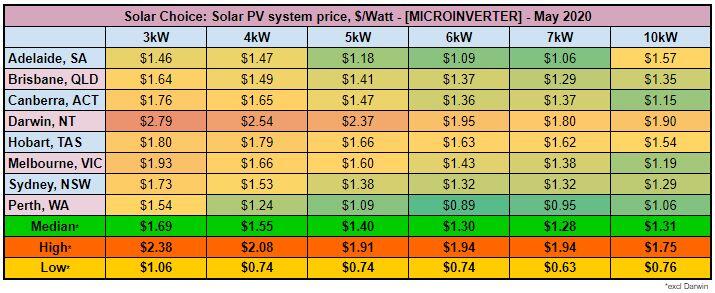
Prices for each system size are colour-coded. (Dark red for highest, dark green for lowest, yellow/orange for in between).
List of products used in microinverter offerings
Please note that the below list is in alphabetical order and does not denote panel-inverter pairings in installer offerings. We also note that Enphase’s microinverters comprise the vast majority of microinverter offerings (roughly 90%).
Also note that strictly speaking SolarEdge systems do not include microinverters, but rather power optimisers. However, they are often lumped in with microinverters because of the fact that they are similarly adept at mitigating the impact of shading and multiple roof orientations.
| Products used in microinverter offerings | |
| Panels | Inverters |
| Canadian Solar | Enphase |
| GCL | SolarEdge |
| Jinko | |
| LG | |
| Longi | |
| Q Cell | |
| REC | |
| Risen | |
| Seraphim | |
| Solar Edge | |
| SolarWatt | |
| Trina | |
| Yingli | |
Historic solar PV system prices (since October 2012)
The historic pricing in the tables below do not reflect prices for Darwin, NT. See ‘About this data’ footnote below for a more detailed description of where this data comes from and what it represents.
Historic Solar PV Price Index Trend (All primary system sizes, $/W)
The chart below provides an at-a-glance look at solar PV system pricing trends since September 2012. Data points are the average of average $/W for popular system sizes (Only 1.5kW-5kW from Aug 2012 to Nov 2013, then also including 10kW from Dec 2013, with 1.5kW dropped and added 7kW from November 2017, and then 2kW dropped and added 6kW from June 2019.)
Compare quotes from up to 7 pre-vetted installers in your area now.
Since 2008 our knowledge and sophisticated software has allowed over 160,000 Australian households and businesses to make a well-informed choice on their solar & battery installer.
About this data
Tables and charts included in this article were compiled using data from Solar Choice’s installer network database, which contains regularly-updated pricing and product details from over 100 solar installation companies across Australia. Prices do not ordinarily incorporate meter installation fees or additional costs for difficult installations. Pricing data from Darwin is not included any of the charts showing historic trends.
© 2019 Solar Choice Pty Ltd
- Solar Panel Costs: Solar Choice Price Index | May 2025 - 1 May, 2025
- Commercial Solar Prices: Current Averages by Capital City - 1 May, 2025
- Solar Battery Costs: Solar Battery Price Index - 1 May, 2025
